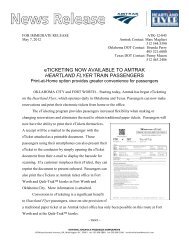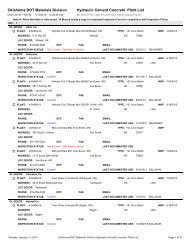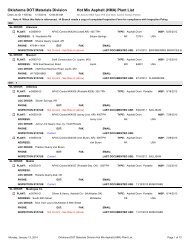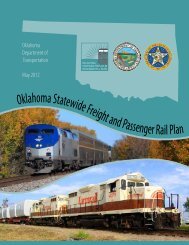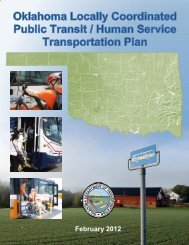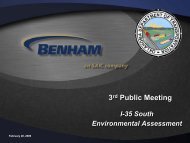Implications of Rail-line Abandonment on Shipper Costs in Eastern ...
Implications of Rail-line Abandonment on Shipper Costs in Eastern ...
Implications of Rail-line Abandonment on Shipper Costs in Eastern ...
Create successful ePaper yourself
Turn your PDF publications into a flip-book with our unique Google optimized e-Paper software.
<str<strong>on</strong>g>Implicati<strong>on</strong>s</str<strong>on</strong>g> <str<strong>on</strong>g>of</str<strong>on</strong>g> <str<strong>on</strong>g>Rail</str<strong>on</strong>g>-<str<strong>on</strong>g>l<strong>in</strong>e</str<strong>on</strong>g><br />
<str<strong>on</strong>g>Aband<strong>on</strong>ment</str<strong>on</strong>g> <strong>on</strong> <strong>Shipper</strong> <strong>Costs</strong> <strong>in</strong><br />
<strong>Eastern</strong> Wash<strong>in</strong>gt<strong>on</strong><br />
Denver Tolliver<br />
Eric L. Jessup<br />
SFTA Co-Pr<strong>in</strong>cipal Investigator<br />
and<br />
Kenneth L. Casavant<br />
SFTA Pr<strong>in</strong>cipal Investigator<br />
SFTA Research Report # 8<br />
September 2003
<str<strong>on</strong>g>Implicati<strong>on</strong>s</str<strong>on</strong>g> <str<strong>on</strong>g>of</str<strong>on</strong>g> <str<strong>on</strong>g>Rail</str<strong>on</strong>g>-<str<strong>on</strong>g>l<strong>in</strong>e</str<strong>on</strong>g> <str<strong>on</strong>g>Aband<strong>on</strong>ment</str<strong>on</strong>g><br />
<strong>on</strong> <strong>Shipper</strong> <strong>Costs</strong> <strong>in</strong> <strong>Eastern</strong> Wash<strong>in</strong>gt<strong>on</strong><br />
by<br />
Denver Tolliver<br />
Eric L. Jessup<br />
SFTA Co-Pr<strong>in</strong>cipal Investigator<br />
and<br />
Kenneth L. Casavant<br />
SFTA Pr<strong>in</strong>cipal Investigator<br />
Research Report #8<br />
September 2003<br />
Wash<strong>in</strong>gt<strong>on</strong> State University<br />
Department <str<strong>on</strong>g>of</str<strong>on</strong>g> Agricultural and Resource Ec<strong>on</strong>omics<br />
101 Hulbert Hall<br />
Pullman, Wash<strong>in</strong>gt<strong>on</strong> 99164-6210
SFTA Research Reports:<br />
Background and Purpose<br />
This is the eighth <str<strong>on</strong>g>of</str<strong>on</strong>g> a series <str<strong>on</strong>g>of</str<strong>on</strong>g> reports prepared from the Strategic Freight Transportati<strong>on</strong><br />
Analysis (SFTA) study. SFTA is a six year comprehensive research and implementati<strong>on</strong><br />
analysis that will provide <strong>in</strong>formati<strong>on</strong> (data and directi<strong>on</strong>) for local, state and nati<strong>on</strong>al<br />
<strong>in</strong>vestments and decisi<strong>on</strong>s designed to achieve the goal <str<strong>on</strong>g>of</str<strong>on</strong>g> seamless transportati<strong>on</strong>.<br />
The overall SFTA scope <strong>in</strong>cludes the follow<strong>in</strong>g goals and objectives:<br />
• Improv<strong>in</strong>g knowledge about freight corridors.<br />
• Assess<strong>in</strong>g the operati<strong>on</strong>s <str<strong>on</strong>g>of</str<strong>on</strong>g> roadways, rail systems, ports and barges –<br />
freight choke po<strong>in</strong>ts.<br />
• Analyze modal cost structures and competitive mode shares.<br />
• Assess potential ec<strong>on</strong>omic development opportunities.<br />
• C<strong>on</strong>duct case studies <str<strong>on</strong>g>of</str<strong>on</strong>g> public/private transportati<strong>on</strong> costs.<br />
• Evaluate the opportunity for public/private partnerships.<br />
The five specific work tasks identified for SFTA are:<br />
• Work Task 1 - Scop<strong>in</strong>g <str<strong>on</strong>g>of</str<strong>on</strong>g> Full Project<br />
• Work Task 2 - Statewide Orig<strong>in</strong> and Dest<strong>in</strong>ati<strong>on</strong> Truck Survey<br />
• Work Task 3 - Short<str<strong>on</strong>g>l<strong>in</strong>e</str<strong>on</strong>g> <str<strong>on</strong>g>Rail</str<strong>on</strong>g>road Ec<strong>on</strong>omic Analysis<br />
• Work Task 4 - Strategic Resources Access Road Network (Critical State<br />
and Local Integrated Network)<br />
• Work Task 5 - Adaptive Research Management<br />
For additi<strong>on</strong>al <strong>in</strong>formati<strong>on</strong> about the SFTA or this report, please c<strong>on</strong>tact Eric Jessup or Ken<br />
Casavant at the follow<strong>in</strong>g address:<br />
Wash<strong>in</strong>gt<strong>on</strong> State University<br />
Department <str<strong>on</strong>g>of</str<strong>on</strong>g> Agricultural and Resource Ec<strong>on</strong>omics<br />
101 Hulbert Hall<br />
Pullman, Wash<strong>in</strong>gt<strong>on</strong> 99164-6210<br />
Or go to the follow<strong>in</strong>g Web Address:<br />
www.sfta.wsu.edu
DISCLAIMER<br />
The c<strong>on</strong>tents <str<strong>on</strong>g>of</str<strong>on</strong>g> this report reflect the views <str<strong>on</strong>g>of</str<strong>on</strong>g> the authors, who are resp<strong>on</strong>sible for the facts and<br />
accuracy <str<strong>on</strong>g>of</str<strong>on</strong>g> the data presented here<strong>in</strong>. The c<strong>on</strong>tents do not necessarily reflect the <str<strong>on</strong>g>of</str<strong>on</strong>g>ficial views<br />
or policies <str<strong>on</strong>g>of</str<strong>on</strong>g> the Wash<strong>in</strong>gt<strong>on</strong> State Department <str<strong>on</strong>g>of</str<strong>on</strong>g> Transportati<strong>on</strong>. This report does not c<strong>on</strong>stitute<br />
a standard, specificati<strong>on</strong> or regulati<strong>on</strong>.<br />
PREVIOUS SFTA REPORTS NOW AVAILABLE<br />
1. Casavant, Kenneth L. and Eric L. Jessup. “SFTA Full Scope <str<strong>on</strong>g>of</str<strong>on</strong>g> Work.” SFTA Research<br />
Report Number 1. December 2002.<br />
2. Clark, Michael L., Eric L. Jessup and Kenneth L. Casavant. “Freight Truck Orig<strong>in</strong> and<br />
Dest<strong>in</strong>ati<strong>on</strong> Study: Methods, Procedures and Data Dicti<strong>on</strong>ary.” SFTA Research Report<br />
Number 2. December 2002.<br />
3. Casavant, Kenneth L. and Eric L. Jessup. “Value <str<strong>on</strong>g>of</str<strong>on</strong>g> Modal Competiti<strong>on</strong> for Transportati<strong>on</strong> <str<strong>on</strong>g>of</str<strong>on</strong>g><br />
Wash<strong>in</strong>gt<strong>on</strong> Fresh Fruits and Vegetables.” SFTA Research Report Number 3. December<br />
2002.<br />
4. Rippl<strong>in</strong>ger, Toby, Kenneth L. Casavant and Eric L. Jessup. “Transportati<strong>on</strong> Usage <str<strong>on</strong>g>of</str<strong>on</strong>g> the<br />
Wash<strong>in</strong>gt<strong>on</strong> W<strong>in</strong>e Industry.” SFTA Research Report Number 4. May 2003.<br />
5. Clark, Michael L., Eric L. Jessup and Kenneth L. Casavant. “Dynamics <str<strong>on</strong>g>of</str<strong>on</strong>g> Wheat and Barley<br />
Shipments <strong>on</strong> Haul Roads to and from Gra<strong>in</strong> Warehouses <strong>in</strong> Wash<strong>in</strong>gt<strong>on</strong> State.” SFTA<br />
Research Report Number 5. September 2003.<br />
6. Casavant, Kenneth L., Eric L. Jessup, and Joe Poire. “An Assessment <str<strong>on</strong>g>of</str<strong>on</strong>g> the Current<br />
Situati<strong>on</strong> <str<strong>on</strong>g>of</str<strong>on</strong>g> the Palouse River and Coulee City <str<strong>on</strong>g>Rail</str<strong>on</strong>g>road and the Future Role <str<strong>on</strong>g>of</str<strong>on</strong>g> the Port <str<strong>on</strong>g>of</str<strong>on</strong>g><br />
Whitman County.” SFTA Research Report Number 6. September 2003.<br />
7. Tolliver, Denver, Eric L. Jessup, and Kenneth L. Casavant. “New Techniques for Estimat<strong>in</strong>g<br />
Impacts <str<strong>on</strong>g>of</str<strong>on</strong>g> <str<strong>on</strong>g>Rail</str<strong>on</strong>g> L<strong>in</strong>e <str<strong>on</strong>g>Aband<strong>on</strong>ment</str<strong>on</strong>g> <strong>on</strong> Highways <strong>in</strong> Wash<strong>in</strong>gt<strong>on</strong>.” SFTA Research Report<br />
Number 7. September 2003.
<str<strong>on</strong>g>Implicati<strong>on</strong>s</str<strong>on</strong>g> <str<strong>on</strong>g>of</str<strong>on</strong>g> <str<strong>on</strong>g>Rail</str<strong>on</strong>g>-<str<strong>on</strong>g>l<strong>in</strong>e</str<strong>on</strong>g> <str<strong>on</strong>g>Aband<strong>on</strong>ment</str<strong>on</strong>g> <strong>on</strong> <strong>Shipper</strong> <strong>Costs</strong> <strong>in</strong><br />
<strong>Eastern</strong> Wash<strong>in</strong>gt<strong>on</strong><br />
TABLE OF CONTENTS<br />
LIST OF TABLES ........................................................................................................................ ii<br />
INTRODUCTION......................................................................................................................... 1<br />
<str<strong>on</strong>g>Rail</str<strong>on</strong>g> L<strong>in</strong>es Subject to Future <str<strong>on</strong>g>Aband<strong>on</strong>ment</str<strong>on</strong>g>................................................................................ 1<br />
Primary Commodities Transported <strong>on</strong> the PCC ......................................................................... 1<br />
Objectives and Overview <str<strong>on</strong>g>of</str<strong>on</strong>g> Report............................................................................................ 1<br />
PROJECTED POST-ABANDONMENT SHIPMENT PATTERNS....................................... 2<br />
Gra<strong>in</strong> ........................................................................................................................................... 2<br />
Food Products ............................................................................................................................. 5<br />
Other Commodities..................................................................................................................... 6<br />
TRUCK CONFIGURATIONS AND COST FACTORS .......................................................... 6<br />
Data Sources ............................................................................................................................... 6<br />
Rocky Mounta<strong>in</strong> Double Trucks................................................................................................. 6<br />
Comb<strong>in</strong>ati<strong>on</strong> Five-Axle Trucks .................................................................................................. 8<br />
Truck <strong>Costs</strong> ............................................................................................................................... 10<br />
SHIPPING COST COMPONENTS.......................................................................................... 11<br />
Gra<strong>in</strong> ......................................................................................................................................... 11<br />
Other Commodities................................................................................................................... 13<br />
RESULTS OF ANALYSIS......................................................................................................... 13<br />
Prime Scenario.......................................................................................................................... 13<br />
Alternative Scenario.................................................................................................................. 14<br />
Potential Variati<strong>on</strong>s <strong>in</strong> Results.................................................................................................. 15<br />
APPENDIX.................................................................................................................................. 18<br />
Sources <str<strong>on</strong>g>of</str<strong>on</strong>g> Traffic Data............................................................................................................. 18<br />
Comparis<strong>on</strong> <str<strong>on</strong>g>of</str<strong>on</strong>g> Travel Times and Distances for Gra<strong>in</strong> Deliveries to Almota and Central Ferry<br />
................................................................................................................................................... 18<br />
i
LIST OF TABLES<br />
Table 1. Cost per T<strong>on</strong> for a Wheat Shipment from Coulee City to Portland Via Ritzville ............3<br />
Table 2. Cost per T<strong>on</strong> for a Wheat Shipment from Coulee City to Portland Via Pasco................ 4<br />
Table 3. Typical Truck Weights (<strong>in</strong> Pounds) for Primary Truck Types......................................... 8<br />
Table 4. Cost Relati<strong>on</strong>ships between Rocky Mounta<strong>in</strong> Double and 5-Axle Trucks ................... 10<br />
Table 5. Truck Unit <strong>Costs</strong>, Empty-Mile Factors, and <strong>Costs</strong> per T<strong>on</strong>-Mile ................................. 11<br />
Table 6. Estimated Change <strong>in</strong> Shipp<strong>in</strong>g <strong>Costs</strong> from Potential PCC L<strong>in</strong>e <str<strong>on</strong>g>Aband<strong>on</strong>ment</str<strong>on</strong>g>: Scenario<br />
1............................................................................................................................................. 14<br />
Table 7. Estimated Change <strong>in</strong> Shipp<strong>in</strong>g <strong>Costs</strong> from Potential PCC L<strong>in</strong>e <str<strong>on</strong>g>Aband<strong>on</strong>ment</str<strong>on</strong>g>: Scenario<br />
2............................................................................................................................................. 14<br />
Table 8. Comparis<strong>on</strong> <str<strong>on</strong>g>of</str<strong>on</strong>g> Rates for Wheat Movements from Coulee City and Ritzville to the<br />
Pacific Coast <strong>in</strong> 286,000-Pound <str<strong>on</strong>g>Rail</str<strong>on</strong>g> Cars............................................................................ 16<br />
Table 9. Truck<strong>in</strong>g Cost for Wheat Shipments from Coulee City to Ritzville <strong>in</strong> Rocky Mounta<strong>in</strong><br />
Doubles ................................................................................................................................. 16<br />
Table 10. Comparis<strong>on</strong> <str<strong>on</strong>g>of</str<strong>on</strong>g> Travel Times and Distances from Select P&L and BLMR Stati<strong>on</strong>s to<br />
Alternative River Ports ......................................................................................................... 18<br />
ii
<str<strong>on</strong>g>Implicati<strong>on</strong>s</str<strong>on</strong>g> <str<strong>on</strong>g>of</str<strong>on</strong>g> <str<strong>on</strong>g>Rail</str<strong>on</strong>g>-<str<strong>on</strong>g>l<strong>in</strong>e</str<strong>on</strong>g> <str<strong>on</strong>g>Aband<strong>on</strong>ment</str<strong>on</strong>g> <strong>on</strong> <strong>Shipper</strong> <strong>Costs</strong> <strong>in</strong><br />
<strong>Eastern</strong> Wash<strong>in</strong>gt<strong>on</strong><br />
INTRODUCTION<br />
The Palouse River and Coulee City <str<strong>on</strong>g>Rail</str<strong>on</strong>g>road (PCC) operates 372 miles <str<strong>on</strong>g>of</str<strong>on</strong>g> light-density <str<strong>on</strong>g>l<strong>in</strong>e</str<strong>on</strong>g>s <strong>in</strong><br />
eastern Wash<strong>in</strong>gt<strong>on</strong>. PCC has raised the possibility that these <str<strong>on</strong>g>l<strong>in</strong>e</str<strong>on</strong>g>s could be aband<strong>on</strong>ed <strong>in</strong> the<br />
next five years. If the <str<strong>on</strong>g>l<strong>in</strong>e</str<strong>on</strong>g>s are aband<strong>on</strong>ed, elevators now shipp<strong>in</strong>g by rail will truck gra<strong>in</strong> to<br />
river ports, where the gra<strong>in</strong> will be transferred to barge for movements to Portland, Kalama, or<br />
L<strong>on</strong>gview. Food manufacturers will truck products to the Tri Cities for subsequent reshipment<br />
by rail to markets <strong>in</strong> the eastern United States. In either case, these agricultural <strong>in</strong>dustries will<br />
experience higher shipp<strong>in</strong>g costs after aband<strong>on</strong>ment than they experience today.<br />
<str<strong>on</strong>g>Rail</str<strong>on</strong>g> L<strong>in</strong>es Subject to Future <str<strong>on</strong>g>Aband<strong>on</strong>ment</str<strong>on</strong>g><br />
The PCC network c<strong>on</strong>sists <str<strong>on</strong>g>of</str<strong>on</strong>g> fours sets <str<strong>on</strong>g>of</str<strong>on</strong>g> <str<strong>on</strong>g>l<strong>in</strong>e</str<strong>on</strong>g>s or subsystems:<br />
1. The Cheney-to-Coulee City <str<strong>on</strong>g>l<strong>in</strong>e</str<strong>on</strong>g><br />
2. The Marshall-to-Pullman <str<strong>on</strong>g>l<strong>in</strong>e</str<strong>on</strong>g> (P&L)<br />
3. The Blue Mounta<strong>in</strong> <str<strong>on</strong>g>Rail</str<strong>on</strong>g>road - North<br />
4. The Blue Mounta<strong>in</strong> <str<strong>on</strong>g>Rail</str<strong>on</strong>g>road - South<br />
The northern divisi<strong>on</strong> <str<strong>on</strong>g>of</str<strong>on</strong>g> the Blue Mounta<strong>in</strong> <str<strong>on</strong>g>Rail</str<strong>on</strong>g>road (BLMR) runs from Hooper Juncti<strong>on</strong><br />
through W<strong>in</strong><strong>on</strong>a and Colfax to Moscow, Idaho. A short branch <str<strong>on</strong>g>of</str<strong>on</strong>g> this <str<strong>on</strong>g>l<strong>in</strong>e</str<strong>on</strong>g> runs northeast from<br />
W<strong>in</strong><strong>on</strong>a to Thornt<strong>on</strong>, a distance <str<strong>on</strong>g>of</str<strong>on</strong>g> 31 miles. The southern divisi<strong>on</strong> <str<strong>on</strong>g>of</str<strong>on</strong>g> the Blue Mounta<strong>in</strong><br />
<str<strong>on</strong>g>Rail</str<strong>on</strong>g>road extends from the UP ma<strong>in</strong><str<strong>on</strong>g>l<strong>in</strong>e</str<strong>on</strong>g> at Wallula Juncti<strong>on</strong> to Walla Walla, where it c<strong>on</strong>nects<br />
with another <str<strong>on</strong>g>l<strong>in</strong>e</str<strong>on</strong>g> runn<strong>in</strong>g from Dayt<strong>on</strong>, Wash<strong>in</strong>gt<strong>on</strong> to West<strong>on</strong>, Oreg<strong>on</strong>.<br />
Primary Commodities Transported <strong>on</strong> the PCC<br />
Gra<strong>in</strong> is the predom<strong>in</strong>ant commodity transported <strong>on</strong> the PCC, compris<strong>in</strong>g 83 percent <str<strong>on</strong>g>of</str<strong>on</strong>g> the<br />
10,700 carloads orig<strong>in</strong>ated or term<strong>in</strong>ated <strong>in</strong> 2000. Food products (mostly canned and frozen<br />
vegetables) account for another 8 percent. The rema<strong>in</strong><strong>in</strong>g carloads c<strong>on</strong>sist <str<strong>on</strong>g>of</str<strong>on</strong>g> chemicals, coal,<br />
petroleum products, and farm equipment or mach<strong>in</strong>ery.<br />
Objectives and Overview <str<strong>on</strong>g>of</str<strong>on</strong>g> Report<br />
The objective <str<strong>on</strong>g>of</str<strong>on</strong>g> this report is to quantity the change <strong>in</strong> shipp<strong>in</strong>g cost that would occur if the PCC<br />
rail <str<strong>on</strong>g>l<strong>in</strong>e</str<strong>on</strong>g>s are aband<strong>on</strong>ed. The preventi<strong>on</strong> or avoidance <str<strong>on</strong>g>of</str<strong>on</strong>g> these costs is a benefit <str<strong>on</strong>g>of</str<strong>on</strong>g> ma<strong>in</strong>ta<strong>in</strong><strong>in</strong>g<br />
short-<str<strong>on</strong>g>l<strong>in</strong>e</str<strong>on</strong>g> railroad service <strong>in</strong> eastern Wash<strong>in</strong>gt<strong>on</strong>. The direct shipp<strong>in</strong>g cost by rail is usually<br />
lower than the comb<strong>in</strong>ed truck-barge cost from PCC stati<strong>on</strong>s to Portland Kalama, or L<strong>on</strong>gview.<br />
On direct rail shipments, a transfer <str<strong>on</strong>g>of</str<strong>on</strong>g> cargo between vehicles and vessels is unnecessary.<br />
Moreover, railroads can move gra<strong>in</strong> <strong>in</strong> units <str<strong>on</strong>g>of</str<strong>on</strong>g> 50 to 75 cars, realiz<strong>in</strong>g ec<strong>on</strong>omies that are not<br />
possible with trucks.<br />
1
The potential change <strong>in</strong> shipp<strong>in</strong>g cost is estimated by compar<strong>in</strong>g the current costs <strong>in</strong>curred by<br />
PCC shippers to projected costs if the rail <str<strong>on</strong>g>l<strong>in</strong>e</str<strong>on</strong>g>s are aband<strong>on</strong>ed. The comp<strong>on</strong>ents <str<strong>on</strong>g>of</str<strong>on</strong>g> this<br />
comparis<strong>on</strong> <strong>in</strong>clude: railroad rates, truck<strong>in</strong>g costs, transfer costs, and barge rates to Portland.<br />
The report focuses solely <strong>on</strong> efficiency ga<strong>in</strong>s or losses. In this approach, it does not matter<br />
which party <strong>in</strong> the distributi<strong>on</strong> cha<strong>in</strong> <strong>in</strong>curs the costs: e.g., agricultural coops, elevators, or<br />
exporters. In the l<strong>on</strong>g-run, a net change <strong>in</strong> shipp<strong>in</strong>g cost has an impact <strong>on</strong> the agricultural<br />
ec<strong>on</strong>omy <str<strong>on</strong>g>of</str<strong>on</strong>g> the state.<br />
In general, the analysis <strong>in</strong>volves the follow<strong>in</strong>g steps:<br />
1. Estimate the quantities <str<strong>on</strong>g>of</str<strong>on</strong>g> each commodity currently mov<strong>in</strong>g by rail and the base<str<strong>on</strong>g>l<strong>in</strong>e</str<strong>on</strong>g> rail<br />
shipp<strong>in</strong>g cost<br />
2. Determ<strong>in</strong>e the probable post-aband<strong>on</strong>ment dest<strong>in</strong>ati<strong>on</strong>s and shipp<strong>in</strong>g patterns for each<br />
stati<strong>on</strong> and commodity<br />
3. Estimate the highway miles from each stati<strong>on</strong> to its post-aband<strong>on</strong>ment dest<strong>in</strong>ati<strong>on</strong>s<br />
4. Determ<strong>in</strong>e the predom<strong>in</strong>ant truck type used to haul each commodity<br />
5. Determ<strong>in</strong>e the maximum gross weight <str<strong>on</strong>g>of</str<strong>on</strong>g> each vehicle and the maximum payload t<strong>on</strong>s<br />
that can be accommodated <strong>in</strong> a s<strong>in</strong>gle trip<br />
6. Based <strong>on</strong> the truck weight and predicted empty miles, estimate the truck<strong>in</strong>g cost per t<strong>on</strong>mile<br />
7. Estimate post-aband<strong>on</strong>ment truck<strong>in</strong>g costs by apply<strong>in</strong>g the cost per t<strong>on</strong>-mile to the t<strong>on</strong>s<br />
currently shipped by rail<br />
8. Estimate barge transfer costs by multiply<strong>in</strong>g the <strong>in</strong>cremental t<strong>on</strong>s transferred times the<br />
transfer cost per t<strong>on</strong><br />
9. Estimate barge shipp<strong>in</strong>g costs by multiply<strong>in</strong>g the barge rate per t<strong>on</strong> to Portland by the<br />
<strong>in</strong>cremental t<strong>on</strong>s transferred at the port<br />
10. Estimate the net change <strong>in</strong> shipp<strong>in</strong>g cost from the sum <str<strong>on</strong>g>of</str<strong>on</strong>g> the comp<strong>on</strong>ent costs<br />
This generalized process is applicable to most gra<strong>in</strong> shipments from PCC stati<strong>on</strong>s. However,<br />
there are excepti<strong>on</strong>s to this generalized procedure. These excepti<strong>on</strong>s will be discussed as they<br />
are encountered <strong>in</strong> the report.<br />
PROJECTED POST-ABANDONMENT SHIPMENT PATTERNS<br />
Gra<strong>in</strong><br />
If the PCC rail <str<strong>on</strong>g>l<strong>in</strong>e</str<strong>on</strong>g>s are aband<strong>on</strong>ed, the gra<strong>in</strong> traffic currently mov<strong>in</strong>g by rail will be moved by<br />
truck to a f<strong>in</strong>al market, a rail ma<strong>in</strong><str<strong>on</strong>g>l<strong>in</strong>e</str<strong>on</strong>g> stati<strong>on</strong>, or a barge transfer facility. Because <str<strong>on</strong>g>of</str<strong>on</strong>g> the trip<br />
distances, direct truck<strong>in</strong>g is an unlikely opti<strong>on</strong>. For example, it is 335 miles from Colfax - which<br />
is located <strong>on</strong> the BLMR North - to the primary market <str<strong>on</strong>g>of</str<strong>on</strong>g> Portland. It is even father from Coulee<br />
City to Portland: 350 miles. Thus, it is unlikely that gra<strong>in</strong> will be trucked directly to f<strong>in</strong>al<br />
market. Instead, it will be trucked to a rail ma<strong>in</strong><str<strong>on</strong>g>l<strong>in</strong>e</str<strong>on</strong>g> or river port.<br />
2
<str<strong>on</strong>g>Rail</str<strong>on</strong>g> Transshipment Opti<strong>on</strong><br />
If the PCC <str<strong>on</strong>g>l<strong>in</strong>e</str<strong>on</strong>g>s are aband<strong>on</strong>ed, some gra<strong>in</strong> could be trucked to the BNSF or UP. For example,<br />
gra<strong>in</strong> from the Cheney-to-Coulee City <str<strong>on</strong>g>l<strong>in</strong>e</str<strong>on</strong>g> could be transshipped via Ritzville. However,<br />
Ritzville would become the shipper. Presumably, the gra<strong>in</strong> would be resold to the Ritzville<br />
Warehouse Company. In essence, the PCC elevators would become satellites. Over time,<br />
farmers may bypass these facilities and deliver gra<strong>in</strong> directly to Ritzville. 1 However, this<br />
adjustment process could take several years and may require a change <strong>in</strong> the farm truck fleet.<br />
Truck-Barge Opti<strong>on</strong><br />
Many PCC elevators already use truck-barge. Jessup (1997) found that 24 percent <str<strong>on</strong>g>of</str<strong>on</strong>g> the gra<strong>in</strong><br />
orig<strong>in</strong>ated from elevators located <strong>on</strong> the Cheney-to-Coulee City and Marshall-to-Moscow <str<strong>on</strong>g>l<strong>in</strong>e</str<strong>on</strong>g>s<br />
moved via truck-barge. 2 The elevators located <strong>on</strong> these <str<strong>on</strong>g>l<strong>in</strong>e</str<strong>on</strong>g>s are relatively far from river ports.<br />
In comparis<strong>on</strong>, BLMR elevators are much closer to Pasco and Central Ferry, and may utilize<br />
truck-barge even more.<br />
<strong>Costs</strong> <str<strong>on</strong>g>of</str<strong>on</strong>g> Transshipment Opti<strong>on</strong>s<br />
A comparis<strong>on</strong> <str<strong>on</strong>g>of</str<strong>on</strong>g> potential post-aband<strong>on</strong>ment shipp<strong>in</strong>g costs is presented <strong>in</strong> Tables 1 and 2 for<br />
wheat mov<strong>in</strong>g from Coulee City to Portland. The comparis<strong>on</strong> reflects 2002 price levels. The<br />
sources <str<strong>on</strong>g>of</str<strong>on</strong>g> the unit costs shown <strong>in</strong> the tables are detailed later <strong>in</strong> the report.<br />
Table 1 shows the total cost <str<strong>on</strong>g>of</str<strong>on</strong>g> a transshipment via Ritzville. In comparis<strong>on</strong>, Table 2 shows the<br />
total cost <str<strong>on</strong>g>of</str<strong>on</strong>g> a transshipment via Pasco. In both cases, the wheat is assumed to move <strong>in</strong> a Rocky<br />
Mounta<strong>in</strong> Double truck. As the comparis<strong>on</strong> shows, the transshipment cost via Pasco is less than<br />
the transshipment cost via Ritzville.<br />
Table 1. Cost per T<strong>on</strong> for a Wheat Shipment from Coulee City to Portland Via Ritzville<br />
Truck Cost per Mile $ 1.40<br />
Trip Distance 91<br />
Cost per Round Trip $ 255<br />
Net T<strong>on</strong>s per Truck 36<br />
Truck Cost per T<strong>on</strong> $ 7.08<br />
Transfer Cost per T<strong>on</strong> $ 1.67<br />
<str<strong>on</strong>g>Rail</str<strong>on</strong>g> Rate per Car <strong>in</strong> 110-Car Tra<strong>in</strong>s $ 907<br />
<str<strong>on</strong>g>Rail</str<strong>on</strong>g> Rate per T<strong>on</strong> $ 8.17<br />
Total Shipment Cost per T<strong>on</strong> $ 16.92<br />
1 Analysis if this scenario is bey<strong>on</strong>d the scope <str<strong>on</strong>g>of</str<strong>on</strong>g> the study, which focuses <strong>on</strong> the most likely <strong>in</strong>termediate-run scenario.<br />
2 Jessup, Eric. Ec<strong>on</strong>omic Evaluati<strong>on</strong> <str<strong>on</strong>g>of</str<strong>on</strong>g> Gra<strong>in</strong> Shipment Alternatives: A Case Study <str<strong>on</strong>g>of</str<strong>on</strong>g> the Coulee City and Palouse River <str<strong>on</strong>g>Rail</str<strong>on</strong>g>road. EWITS<br />
Work<strong>in</strong>g Paper Number 8, March 1997.<br />
3
Notes: Rates and costs reflect 2002 levels. Calculated values are rounded for purposes <str<strong>on</strong>g>of</str<strong>on</strong>g><br />
presentati<strong>on</strong>.<br />
Table 2. Cost per T<strong>on</strong> for a Wheat Shipment from Coulee City to Portland Via Pasco<br />
Truck Cost per Mile $ 1.40<br />
Trip Distance 116<br />
Cost per Round Trip $ 325<br />
Net T<strong>on</strong>s per Truck 36<br />
Truck Cost per T<strong>on</strong> $ 9.02<br />
Transfer Cost per T<strong>on</strong> $ 1.67<br />
Barge Rate: Pasco-Portland $ 5.53<br />
Shipment Cost per T<strong>on</strong> $ 16.22<br />
Notes: Rates and costs reflect 2002 levels. Calculated values are rounded for purposes <str<strong>on</strong>g>of</str<strong>on</strong>g><br />
presentati<strong>on</strong>.<br />
Based <strong>on</strong> the shipp<strong>in</strong>g cost comparis<strong>on</strong>, it appears that most <str<strong>on</strong>g>of</str<strong>on</strong>g> the gra<strong>in</strong> will be trucked to Pasco,<br />
W<strong>in</strong>dust, or Central Ferry. These ports have sufficient capacity to handle substantial <strong>in</strong>creases <strong>in</strong><br />
gra<strong>in</strong> throughput. Moreover, they have good highway access. Presumably, gra<strong>in</strong> produced <strong>in</strong> the<br />
Walla Walla regi<strong>on</strong> will be transshipped at Wallula.<br />
Mode Choice Factors<br />
Total shipment cost is the predom<strong>in</strong>ant factor <strong>in</strong> mode choice. 3 However, other variables may<br />
affect an elevator’s post-aband<strong>on</strong>ment shipp<strong>in</strong>g decisi<strong>on</strong>s. Instituti<strong>on</strong>al factors such as jo<strong>in</strong>t<br />
ownership or f<strong>in</strong>ancial <strong>in</strong>tegrati<strong>on</strong> <str<strong>on</strong>g>of</str<strong>on</strong>g> elevator and port facilities are important c<strong>on</strong>siderati<strong>on</strong>s.<br />
Service factors such as total transit time, variability <strong>in</strong> transit time, and equipment availability are<br />
also important. In some <strong>in</strong>stances, shippers may realize premiums <strong>in</strong> the export market if they<br />
can assemble and deliver a shipment <str<strong>on</strong>g>of</str<strong>on</strong>g> gra<strong>in</strong> <strong>on</strong> short notice. 4 Another factor is the capacity and<br />
availability <str<strong>on</strong>g>of</str<strong>on</strong>g> equipment. If car supply isn’t reliable or car-order cycles are lengthy, shippers<br />
may perceive that rail service is less reliable than truck-barge service.<br />
Most Likely Post <str<strong>on</strong>g>Aband<strong>on</strong>ment</str<strong>on</strong>g> Dest<strong>in</strong>ati<strong>on</strong>s<br />
In 2000, over 80 percent <str<strong>on</strong>g>of</str<strong>on</strong>g> the gra<strong>in</strong> orig<strong>in</strong>ated by rail from PCC stati<strong>on</strong>s was dest<strong>in</strong>ed for<br />
Portland, Vancouver, or Kalama. 5 The rema<strong>in</strong>der moved to Puget Sound ports, or to dispersed<br />
3 In estimat<strong>in</strong>g post-aband<strong>on</strong>ment shipp<strong>in</strong>g costs, highway distances and travel times were estimated for alternative port dest<strong>in</strong>ati<strong>on</strong>s from<br />
highway maps and Internet mapp<strong>in</strong>g services. Differences <strong>in</strong> downriver barge rates from alternative ports were computed from Tidewater Barge<br />
L<strong>in</strong>es rate schedule.<br />
4 Tidewater Barge L<strong>in</strong>es advertises 36-hour transit times from Tri-Cities to Portland. Gra<strong>in</strong> can be trucked from elevators <strong>on</strong> the Coulee City <str<strong>on</strong>g>l<strong>in</strong>e</str<strong>on</strong>g><br />
to Tri-Cities <strong>in</strong> a matter <str<strong>on</strong>g>of</str<strong>on</strong>g> hours. Thus, the time c<strong>on</strong>sumed dur<strong>in</strong>g a truck-barge shipment may be 48 hours or less.<br />
5 Estimated from the 2000 <str<strong>on</strong>g>Rail</str<strong>on</strong>g>road Carload Waybill Sample.<br />
4
markets <strong>in</strong> small quantities. 6 If the rail <str<strong>on</strong>g>l<strong>in</strong>e</str<strong>on</strong>g>s are aband<strong>on</strong>ed, gra<strong>in</strong> orig<strong>in</strong>ated from PCC stati<strong>on</strong>s<br />
could move to the Puget Sound <strong>on</strong>ly if it is trucked there or transshipped via a ma<strong>in</strong><str<strong>on</strong>g>l<strong>in</strong>e</str<strong>on</strong>g> elevator.<br />
Without direct rail service, gra<strong>in</strong> shipments to dispersed domestic markets would cease or shift to<br />
export markets. Thus, if the PCC <str<strong>on</strong>g>l<strong>in</strong>e</str<strong>on</strong>g>s are aband<strong>on</strong>ed, all <str<strong>on</strong>g>of</str<strong>on</strong>g> the gra<strong>in</strong> currently mov<strong>in</strong>g by rail<br />
would be trucked to river ports and transferred to barge for subsequent movement to Columbia<br />
River seaports. 7<br />
Alternative Ports for Palouse Regi<strong>on</strong> Gra<strong>in</strong><br />
Some <str<strong>on</strong>g>of</str<strong>on</strong>g> the elevators located <strong>on</strong> the eastern end <str<strong>on</strong>g>of</str<strong>on</strong>g> the BLMR North and the P&L currently ship<br />
via Almota. However, Almota has no capacity for expansi<strong>on</strong>. It is a small port c<strong>on</strong>sist<strong>in</strong>g <str<strong>on</strong>g>of</str<strong>on</strong>g> 11<br />
acres. Moreover, it has relatively poor highway access. It is not served by a state highway.<br />
Access from Colfax is via 13 miles <str<strong>on</strong>g>of</str<strong>on</strong>g> county and local roads.<br />
The Almota Road, which all traffic must use, <strong>in</strong>cludes a 7 percent grade. Accord<strong>in</strong>g to the Port<br />
<str<strong>on</strong>g>of</str<strong>on</strong>g> Whitman County, the steepness <str<strong>on</strong>g>of</str<strong>on</strong>g> the grade causes several truck accidents each year. 8 As<br />
many as 100 trucks per day may travel the road dur<strong>in</strong>g peak periods. 9 Moreover, the road is<br />
heavily used by recreati<strong>on</strong>al traffic. 10 Dur<strong>in</strong>g spr<strong>in</strong>g thaw, the Almota road is closed to trucks. 11<br />
In comparis<strong>on</strong>, Central Ferry has good highway access, via SR-26 and SR-127. Several shipper<br />
associati<strong>on</strong>s own facilities at Central Ferry, <strong>in</strong>clud<strong>in</strong>g Cooperative Agricultural Producers and<br />
Rosalia Producers. In additi<strong>on</strong>, Columbia Gra<strong>in</strong> and Wilbur Ellis are located at Central Ferry.<br />
Although trip distances to Almota may be shorter from some elevators, <strong>in</strong> most cases the travel<br />
times to Central Ferry are actually less (Appendix). Moreover, there is a slight barge rate<br />
advantage at Central Ferry.<br />
For the reas<strong>on</strong>s cited above, it is assumed that the gra<strong>in</strong> handled at stati<strong>on</strong>s <strong>on</strong> the eastern end <str<strong>on</strong>g>of</str<strong>on</strong>g><br />
the BLMR North and P&L will be transshipped primarily through Central Ferry if the rail <str<strong>on</strong>g>l<strong>in</strong>e</str<strong>on</strong>g>s<br />
are aband<strong>on</strong>ed. However, the report <strong>in</strong>cludes a sensitivity analysis and a comparis<strong>on</strong> <str<strong>on</strong>g>of</str<strong>on</strong>g> costs<br />
under the two alternative scenarios.<br />
Food Products<br />
Food products shipments orig<strong>in</strong>ated from stati<strong>on</strong>s <strong>on</strong> the BLMR South are dest<strong>in</strong>ed primarily for<br />
the eastern and southeastern United States. In some cases, these commodities are moved nearly<br />
3,000 miles by rail. If the PCC <str<strong>on</strong>g>l<strong>in</strong>e</str<strong>on</strong>g>s are aband<strong>on</strong>ed, food manufacturers will truck their products<br />
to the Tri-Cities for subsequent re-shipment by rail.<br />
6 Ibid.<br />
7 Central Wash<strong>in</strong>gt<strong>on</strong> Gra<strong>in</strong> Growers, Cooperative Agricultural Producers, St John Gra<strong>in</strong> Growers, and Rosalia Producers provided <strong>in</strong>formati<strong>on</strong><br />
about post-aband<strong>on</strong>ment dest<strong>in</strong>ati<strong>on</strong>s. Their <strong>in</strong>formati<strong>on</strong> c<strong>on</strong>firmed the analysis presented <strong>in</strong> this paragraph.<br />
8 Port <str<strong>on</strong>g>of</str<strong>on</strong>g> Whitman County. Port Comprehensive Plan. December, 2000.<br />
9 Ibid.<br />
10 Ibid.<br />
11 Ibid.<br />
5
Other Commodities<br />
A small quantity <str<strong>on</strong>g>of</str<strong>on</strong>g> coal moves <strong>in</strong>to the area from orig<strong>in</strong>s southeast <str<strong>on</strong>g>of</str<strong>on</strong>g> Wash<strong>in</strong>gt<strong>on</strong>. These<br />
shipments travel approximately 1,000 miles by rail. Inbound chemical shipments are orig<strong>in</strong>ated<br />
from Canada or locati<strong>on</strong>s east <str<strong>on</strong>g>of</str<strong>on</strong>g> the PCC. These shipments are dest<strong>in</strong>ed primarily for stati<strong>on</strong>s<br />
located <strong>on</strong> the BLMR North. They are moved 700 to 1,100 miles by rail. Inbound shipments <str<strong>on</strong>g>of</str<strong>on</strong>g><br />
farm equipment orig<strong>in</strong>ate primarily from the Great Pla<strong>in</strong>s regi<strong>on</strong>, as far away as Ill<strong>in</strong>ois. These<br />
shipments are very <strong>in</strong>frequent. However, they move l<strong>on</strong>g distances. For example, shipments <str<strong>on</strong>g>of</str<strong>on</strong>g><br />
farm equipment travel 1,000 to 1,900 miles by rail to stati<strong>on</strong>s <strong>on</strong> the PCC.<br />
The sources <str<strong>on</strong>g>of</str<strong>on</strong>g> these commodities are dispersed across the United States and Canada. Truck<br />
deliveries may be impractical from distant orig<strong>in</strong>s. A reas<strong>on</strong>able assumpti<strong>on</strong> is that these<br />
commodities will move <strong>in</strong>to a regi<strong>on</strong>al distributi<strong>on</strong> center by rail, where they will be transferred<br />
to truck. S<strong>in</strong>ce most <str<strong>on</strong>g>of</str<strong>on</strong>g> the chemical and farm mach<strong>in</strong>ery shipments are orig<strong>in</strong>ated east or north<br />
<str<strong>on</strong>g>of</str<strong>on</strong>g> the study area, it is assumed that these commodities will be transferred at Spokane.<br />
Presumably, the coal traffic that is orig<strong>in</strong>ated south <str<strong>on</strong>g>of</str<strong>on</strong>g> the study area will be transferred at Tri-<br />
Cities.<br />
TRUCK CONFIGURATIONS AND COST FACTORS<br />
Data Sources<br />
Two sources <str<strong>on</strong>g>of</str<strong>on</strong>g> <strong>in</strong>formati<strong>on</strong> were used to determ<strong>in</strong>e the predom<strong>in</strong>ant truck type for each<br />
commodity: (1) a survey <str<strong>on</strong>g>of</str<strong>on</strong>g> PCC shippers, and (2) truck size and weight studies c<strong>on</strong>ducted by the<br />
U.S. DOT. Teleph<strong>on</strong>e <strong>in</strong>terviews were c<strong>on</strong>ducted with shippers <strong>in</strong> eastern Wash<strong>in</strong>gt<strong>on</strong> <strong>in</strong> late<br />
2001 and 2002. <strong>Shipper</strong>s were asked about the types <str<strong>on</strong>g>of</str<strong>on</strong>g> trucks used, their truck<strong>in</strong>g costs, and the<br />
river ports to which they would deliver gra<strong>in</strong> if the PCC rail <str<strong>on</strong>g>l<strong>in</strong>e</str<strong>on</strong>g>s are aband<strong>on</strong>ed.<br />
In additi<strong>on</strong> to the survey, a series <str<strong>on</strong>g>of</str<strong>on</strong>g> work<strong>in</strong>g papers used <strong>in</strong> the U.S. DOT’s Comprehensive<br />
Truck Size and Weight Study were reviewed for background <strong>in</strong>formati<strong>on</strong>. Some <str<strong>on</strong>g>of</str<strong>on</strong>g> these papers<br />
<strong>in</strong>clude estimates <str<strong>on</strong>g>of</str<strong>on</strong>g> the operat<strong>in</strong>g costs associated with relevant truck c<strong>on</strong>figurati<strong>on</strong>s.<br />
Rocky Mounta<strong>in</strong> Double Trucks<br />
If the PCC rail <str<strong>on</strong>g>l<strong>in</strong>e</str<strong>on</strong>g>s are aband<strong>on</strong>ed, gra<strong>in</strong> now mov<strong>in</strong>g by rail will be trucked to river ports <strong>in</strong><br />
Rocky Mounta<strong>in</strong> Doubles. A Rocky Mounta<strong>in</strong> Double (RMD) c<strong>on</strong>sists <str<strong>on</strong>g>of</str<strong>on</strong>g> a tractor pull<strong>in</strong>g a<br />
semitrailer, followed by a smaller “pup” trailer. Overall, this truck has 7 axles:<br />
• A s<strong>in</strong>gle steer<strong>in</strong>g axle <strong>on</strong> the tractor<br />
• Two sets <str<strong>on</strong>g>of</str<strong>on</strong>g> tandem axles: a tractor driv<strong>in</strong>g axle and a tandem axle underneath the semitrailer<br />
• Two s<strong>in</strong>gle axles underneath the pup trailer<br />
6
Maximum Gross Weight<br />
When fully loaded, a RMD weighs 105,500 pounds. However, the tare weight <str<strong>on</strong>g>of</str<strong>on</strong>g> the truck varies<br />
with the trailers’ dimensi<strong>on</strong>s and materials. Both the semitrailer and pup trailer are “hopper”<br />
trailers, c<strong>on</strong>structed with <strong>on</strong>e or more hopper b<strong>in</strong>s. However, there are many variati<strong>on</strong>s <strong>in</strong><br />
length, width, and number <str<strong>on</strong>g>of</str<strong>on</strong>g> b<strong>in</strong>s. Semitrailers may range from 40 to 45 feet <strong>in</strong> length, with 1 or<br />
2 hopper b<strong>in</strong>s. A pup trailer may range from 18 to 28 feet <strong>in</strong> length. Some trailers <str<strong>on</strong>g>of</str<strong>on</strong>g> the same<br />
dimensi<strong>on</strong>s are heavier than others due to differences <strong>in</strong> materials.<br />
Tare Weight<br />
Several <str<strong>on</strong>g>of</str<strong>on</strong>g> the elevator and grower associati<strong>on</strong>s <strong>in</strong> eastern Wash<strong>in</strong>gt<strong>on</strong> own Rocky Mounta<strong>in</strong><br />
Doubles and provide their own truck<strong>in</strong>g services. On average, these associati<strong>on</strong>s report tare<br />
weights rang<strong>in</strong>g from 32,000 to 35,500 pounds. U.S. Department <str<strong>on</strong>g>of</str<strong>on</strong>g> Transportati<strong>on</strong> studies<br />
provide some <strong>in</strong>formati<strong>on</strong> about the tare weights <str<strong>on</strong>g>of</str<strong>on</strong>g> commercial trucks. A work<strong>in</strong>g paper<br />
prepared for the Comprehensive Truck Size and Weight Study lists a tare weight <str<strong>on</strong>g>of</str<strong>on</strong>g> 33,000<br />
pounds for a l<strong>on</strong>g-wheel base tractor, a 42-foot semitrailer, and a 28-foot pup trailer. 12<br />
Because <str<strong>on</strong>g>of</str<strong>on</strong>g> variati<strong>on</strong>s <strong>in</strong> equipment weights, a midpo<strong>in</strong>t tare weight <str<strong>on</strong>g>of</str<strong>on</strong>g> 33,500 pounds is used <strong>in</strong><br />
this study. This tare weight yields a net weight <str<strong>on</strong>g>of</str<strong>on</strong>g> 36 t<strong>on</strong>s per truck. This load factor was verified<br />
through c<strong>on</strong>versati<strong>on</strong>s with shippers <strong>in</strong> the area. S<strong>in</strong>ce the maximum gross weight <str<strong>on</strong>g>of</str<strong>on</strong>g> the truck is<br />
105,500 pounds, the corresp<strong>on</strong>d<strong>in</strong>g tare weight must be 33,500 pounds.<br />
Cost per Mile<br />
The cost <str<strong>on</strong>g>of</str<strong>on</strong>g> mov<strong>in</strong>g wheat <strong>in</strong> a 7-axle Rocky Mounta<strong>in</strong> Double is approximately $1.40 per<br />
mile. 13 The truck’s hopper trailers are very efficient, allow<strong>in</strong>g for rapid bottom discharge <str<strong>on</strong>g>of</str<strong>on</strong>g><br />
gra<strong>in</strong>. However, it is difficult for truckers to obta<strong>in</strong> a backhaul for these trailers. Certa<strong>in</strong> dry<br />
fertilizers and other f<strong>in</strong>ely-divisible commodities can be hauled <strong>in</strong> them. However, a backhaul<br />
usually requires that the trailers be cleaned thoroughly before they are reloaded with gra<strong>in</strong>.<br />
Empty-Mile Ratio<br />
Because <str<strong>on</strong>g>of</str<strong>on</strong>g> the specialized nature <str<strong>on</strong>g>of</str<strong>on</strong>g> the equipment and risks <str<strong>on</strong>g>of</str<strong>on</strong>g> c<strong>on</strong>tam<strong>in</strong>ati<strong>on</strong>, the RMD runs<br />
empty half <str<strong>on</strong>g>of</str<strong>on</strong>g> the time <strong>on</strong> short trips. 14 In essence, the trucker unloads the gra<strong>in</strong> and returns<br />
home empty.<br />
This empty-mile factor is slightly higher than the 40 percent factor used for hopper trailers <strong>in</strong> the<br />
U.S. DOT Comprehensive Truck Size and Weight Study. 15 However, the majority <str<strong>on</strong>g>of</str<strong>on</strong>g> trucks used<br />
12 The RMD tare weight is shown <strong>in</strong> Table 1.10 <str<strong>on</strong>g>of</str<strong>on</strong>g>: Comprehensive Truck Size and Weight (TS&W) Study Phase 1-Synthesis, Truck <strong>Costs</strong> and<br />
Truck Size and Weight Regulati<strong>on</strong>s- Work<strong>in</strong>g Paper 7, February 1995. Prepared for the U.S. Department <str<strong>on</strong>g>of</str<strong>on</strong>g> Transportati<strong>on</strong> by the Battelle Team.<br />
13 This average is based <strong>on</strong> c<strong>on</strong>versati<strong>on</strong>s with several shippers <strong>in</strong> the area <strong>in</strong>clud<strong>in</strong>g Whitman County Gra<strong>in</strong> Growers.<br />
14 Source: teleph<strong>on</strong>e <strong>in</strong>terviews with gra<strong>in</strong> shippers <strong>in</strong> eastern Wash<strong>in</strong>gt<strong>on</strong>.<br />
15 The empty-mile ratio is derived from Appendix A <str<strong>on</strong>g>of</str<strong>on</strong>g> a report by Jack Faucett Associates: The Effects <str<strong>on</strong>g>of</str<strong>on</strong>g> Truck Size and Weight Limits <strong>on</strong><br />
Truck <strong>Costs</strong>. A Work<strong>in</strong>g Paper prepared for the U.S. Department <str<strong>on</strong>g>of</str<strong>on</strong>g> Transportati<strong>on</strong>, October 1991.<br />
7
to haul gra<strong>in</strong> to Snake or Columbia River ports are owned or leased by shipper associati<strong>on</strong>s.<br />
Very few backhaul opportunities exist for these trucks.<br />
Total Trip Cost<br />
In this study, total trip cost is obta<strong>in</strong>ed by divid<strong>in</strong>g the loaded miles by the proporti<strong>on</strong> <str<strong>on</strong>g>of</str<strong>on</strong>g> trip<br />
miles that are loaded, and multiply<strong>in</strong>g by the cost per mile. Thus, the cost per loaded mile <strong>in</strong> a<br />
Rocky Mounta<strong>in</strong> Double is $2.80. S<strong>in</strong>ce the Rocky Mounta<strong>in</strong> Double can accommodate 36<br />
payload t<strong>on</strong>s, the cost per t<strong>on</strong>-mile is 7.8 cents.<br />
Comb<strong>in</strong>ati<strong>on</strong> Five-Axle Trucks<br />
For the most part, manufactured and processed goods move <strong>in</strong> 5-axle tractor-semitrailer<br />
comb<strong>in</strong>ati<strong>on</strong>s, as do sporadic shipments <str<strong>on</strong>g>of</str<strong>on</strong>g> other commodities. The 5-axle tractor-semitrailer is<br />
the most comm<strong>on</strong> commercial truck <strong>on</strong> the road. It is legal <strong>in</strong> all 50 states. In comparis<strong>on</strong>, the<br />
Rocky Mounta<strong>in</strong> Double can operate <strong>on</strong>ly <strong>in</strong> designated states, and <strong>in</strong> some cases, <strong>on</strong>ly <strong>on</strong><br />
designated highways.<br />
Table 3 shows typical tare and gross weights <str<strong>on</strong>g>of</str<strong>on</strong>g> trucks used to move commodities to and from<br />
PCC stati<strong>on</strong>s. Because <str<strong>on</strong>g>of</str<strong>on</strong>g> the tandem-axle excepti<strong>on</strong> to Bridge Formula B, many 5-axle trucks<br />
can be loaded to 80,000 pounds. 16 However, trucks with wheel bases <str<strong>on</strong>g>of</str<strong>on</strong>g> less than 36 feet may be<br />
restricted to 78,000 pounds.<br />
Table 3. Typical Truck Weights (<strong>in</strong> Pounds) for Primary Truck Types<br />
Truck C<strong>on</strong>figurati<strong>on</strong><br />
Tare<br />
Weight<br />
Gross<br />
Weight<br />
Net<br />
Weight<br />
7-Axle Rocky Mounta<strong>in</strong> Double 33,500 105,500 72,000<br />
5-Axle 48’ Dry Van Semitrailer 26,800 78,000 51,200<br />
5-Axle 48’ Reefer Semitrailer 28,700 78,000 49,300<br />
5-Axle 48’ Flatbed Semitrailer 26,400 78,000 51,600<br />
5-Axle 48’ Tanker Semitrailer 23,400 78,000 54,600<br />
5-Axle 40’ Dump Trailer 26,900 78,000 51,100<br />
5-Axle 42’ Hopper Trailer 26,400 78,000 51,600<br />
With the excepti<strong>on</strong> <str<strong>on</strong>g>of</str<strong>on</strong>g> the RMD, the weights shown <strong>in</strong> Table 3 are derived from Faucett (1991).<br />
For 5-axle trucks, the implicati<strong>on</strong> is that the additi<strong>on</strong>al cost <str<strong>on</strong>g>of</str<strong>on</strong>g> a l<strong>on</strong>ger-wheel base tractor and/or<br />
a l<strong>on</strong>ger trailer is not worth the additi<strong>on</strong>al expense.<br />
16 Bridge Formula B allows 68,000 pounds <strong>on</strong> any c<strong>on</strong>secutive set <str<strong>on</strong>g>of</str<strong>on</strong>g> tandem axles when the distance from the center <str<strong>on</strong>g>of</str<strong>on</strong>g> the first axle to the<br />
center <str<strong>on</strong>g>of</str<strong>on</strong>g> the fourth axle is at least 36 feet. This excepti<strong>on</strong> allows some shorter wheel-base vehicles to operate at 80,000 pounds with a sufficient<br />
tractor wheel base so that the “tractor bridge” is not <strong>in</strong> violati<strong>on</strong> <str<strong>on</strong>g>of</str<strong>on</strong>g> the bridge formula.<br />
8
Refrigerated Van Trailers<br />
A significant quantity <str<strong>on</strong>g>of</str<strong>on</strong>g> canned and frozen vegetables is shipped <strong>on</strong> the PCC <strong>in</strong> refrigerated<br />
boxcars. If these perishable products are shifted to trucks, they will be shipped <strong>in</strong> refrigerated<br />
van trailers (reefers). The typical tare weight <str<strong>on</strong>g>of</str<strong>on</strong>g> a comb<strong>in</strong>ati<strong>on</strong> 5-axle truck with a refrigerated<br />
van trailer is 28,700 pounds (Table 3). This tare weight <strong>in</strong>cludes the weight <str<strong>on</strong>g>of</str<strong>on</strong>g> a c<strong>on</strong>venti<strong>on</strong>al<br />
tractor (13,900 pounds) and a tandem-axle semitrailer weigh<strong>in</strong>g 13,300 pounds. 17 If this truck<br />
operates at 78,000 pounds, it can accommodate 49,300 pounds <str<strong>on</strong>g>of</str<strong>on</strong>g> payload.<br />
Refrigerated van trailers are more flexible than hopper trailers and can be used to backhaul<br />
similar commodities <strong>in</strong> canned, packaged, or boxed form. Accord<strong>in</strong>g to Faucett (1991),<br />
refrigerated van trailers <strong>in</strong>cur 15 percent empty miles per year. 18<br />
Tanker Trailers<br />
Chemical and petroleum products move <strong>in</strong> specialized tanker trailers. Accord<strong>in</strong>g to Faucett<br />
(1991), the cost <str<strong>on</strong>g>of</str<strong>on</strong>g> a tanker trailer is approximately 2.3 times the cost <str<strong>on</strong>g>of</str<strong>on</strong>g> a hopper trailer <str<strong>on</strong>g>of</str<strong>on</strong>g><br />
comparable length. The typical tare weight <str<strong>on</strong>g>of</str<strong>on</strong>g> a tanker truck with a c<strong>on</strong>venti<strong>on</strong>al tractor is<br />
23,400 pounds (Table 3). If this truck operates at 78,000 pounds, it can accommodate 54,600<br />
pounds <str<strong>on</strong>g>of</str<strong>on</strong>g> payload. Accord<strong>in</strong>g to Faucett (1991), tanker trailers <strong>in</strong>cur 45 percent empty miles per<br />
year. 19<br />
Flatbed Trailers<br />
A small amount <str<strong>on</strong>g>of</str<strong>on</strong>g> farm equipment or mach<strong>in</strong>ery moves to stati<strong>on</strong>s located <strong>on</strong> the PCC. Heavy<br />
mach<strong>in</strong>ery and equipment typically move <strong>on</strong> railroad flatcars. If shipped by truck, these products<br />
would move <strong>on</strong> flatbed trailers.<br />
The typical tare weight <str<strong>on</strong>g>of</str<strong>on</strong>g> a 48-foot flatbed semitrailer and tractor is 26,400 pounds (Table 3).<br />
This <strong>in</strong>cludes the weight <str<strong>on</strong>g>of</str<strong>on</strong>g> a c<strong>on</strong>venti<strong>on</strong>al tractor and a tandem-axle semitrailer weigh<strong>in</strong>g 12,500<br />
pounds. 20 The typical net weight <str<strong>on</strong>g>of</str<strong>on</strong>g> a flatbed truck operat<strong>in</strong>g at 78,000 pounds is 51,600 pounds.<br />
However, the net weight may be significantly less for farm equipment. Farm tractors and<br />
mach<strong>in</strong>ery are n<strong>on</strong>-divisible loads that tend to occupy the space <str<strong>on</strong>g>of</str<strong>on</strong>g> a flatbed trailer before the<br />
truck reaches its weight limit.<br />
17 The refrigerated van tare weight is computed from equipment weights shown <strong>in</strong> Table 1.5 <str<strong>on</strong>g>of</str<strong>on</strong>g> Comprehensive Truck Size and Weight (TS&W)<br />
Study Phase 1-Synthesis, Truck <strong>Costs</strong> and Truck Size and Weight Regulati<strong>on</strong>s: Work<strong>in</strong>g Paper 7, February 1995. Prepared for the U.S.<br />
Department <str<strong>on</strong>g>of</str<strong>on</strong>g> Transportati<strong>on</strong> by the Battelle Team.<br />
18 The empty-mile ratio for refrigerated vans is derived from Appendix A <str<strong>on</strong>g>of</str<strong>on</strong>g> a report by Jack Faucett Associates: The Effects <str<strong>on</strong>g>of</str<strong>on</strong>g> Truck Size and<br />
Weight Limits <strong>on</strong> Truck <strong>Costs</strong>. A Work<strong>in</strong>g Paper prepared for the U.S. Department <str<strong>on</strong>g>of</str<strong>on</strong>g> Transportati<strong>on</strong>, October 1991.<br />
19 Ibid.<br />
20 The flatbed truck tare weight is computed from equipment weights shown <strong>in</strong> Table 1.5 <str<strong>on</strong>g>of</str<strong>on</strong>g> Comprehensive Truck Size and Weight (TS&W)<br />
Study Phase 1-Synthesis, Truck <strong>Costs</strong> and Truck Size and Weight Regulati<strong>on</strong>s: Work<strong>in</strong>g Paper 7, February 1995. Prepared for the U.S.<br />
Department <str<strong>on</strong>g>of</str<strong>on</strong>g> Transportati<strong>on</strong> by the Battelle Team.<br />
9
In this study, the average truck payload is assumed to be the same as the average flatcar load - 21<br />
t<strong>on</strong>s or 36,000 pounds. 21 Accord<strong>in</strong>g to Faucett (1991), flatbed semitrailers <strong>in</strong>cur 25 percent<br />
empty miles per year. 22<br />
Dump Trailers<br />
The typical tare weight <str<strong>on</strong>g>of</str<strong>on</strong>g> a 40-foot dump trailer that might be used to haul coal is 26,900 pounds<br />
(Table 3). At a gross weight <str<strong>on</strong>g>of</str<strong>on</strong>g> 78,000 pounds, this truck can accommodate 51,100 pounds <str<strong>on</strong>g>of</str<strong>on</strong>g><br />
payload.<br />
Truck <strong>Costs</strong><br />
As noted earlier, the operat<strong>in</strong>g cost <str<strong>on</strong>g>of</str<strong>on</strong>g> a Rocky Mounta<strong>in</strong> Double was obta<strong>in</strong>ed from shippers<br />
located <strong>on</strong> the PCC who operate these trucks <strong>in</strong> shuttle service. Other truck costs are derived<br />
from this value, us<strong>in</strong>g cost relati<strong>on</strong>ships shown <strong>in</strong> the U.S. DOT Truck Size and Weight Study.<br />
U.S. DOT Estimates<br />
Table 4 shows unit costs for a 7-Axle Rocky Mounta<strong>in</strong> Double operat<strong>in</strong>g at 105,500 pounds and<br />
a variety <str<strong>on</strong>g>of</str<strong>on</strong>g> 5-axle semitrailer trucks operat<strong>in</strong>g at 78,000 pounds. The costs reflect 1994 price<br />
levels.<br />
Table 4. Cost Relati<strong>on</strong>ships between Rocky Mounta<strong>in</strong> Double and 5-Axle Trucks<br />
Truck C<strong>on</strong>figurati<strong>on</strong><br />
Cost per Mile<br />
7-Axle Rocky Mounta<strong>in</strong> Double $ 1.36<br />
Percent <str<strong>on</strong>g>of</str<strong>on</strong>g><br />
RMD Cost<br />
5-Axle 48’ Dry Van Semitrailer $ 1.19 88%<br />
5-Axle 48’ Reefer Semitrailer $ 1.29 95%<br />
5-Axle 48’ Flatbed Semitrailer $ 1.19 87%<br />
5-Axle 48’ Tanker Semitrailer $ 1.49 110%<br />
5-Axle 40’ Dump Trailer $ 1.15 84%<br />
5-Axle 42’ Hopper Trailer $ 1.14 84%<br />
Source: Jack Faucett Associates (1991). <strong>Costs</strong> <strong>in</strong>dexed to 1994 price levels.<br />
The Rocky Mounta<strong>in</strong> Double unit cost is close to the cost per mile provided by Whitman County<br />
Gra<strong>in</strong> Growers, which reflects late 2001 - early 2002 levels. One <str<strong>on</strong>g>of</str<strong>on</strong>g> the reas<strong>on</strong>s the costs are<br />
similar is that highway diesel fuel prices were almost identical dur<strong>in</strong>g the two periods. For<br />
example, highway diesel fuel prices ranged from $1.10 to $1.15 per gall<strong>on</strong> dur<strong>in</strong>g the last quarter<br />
21 This value is computed from 1998-2000 sample waybill data.<br />
22 This empty-mile ratio is derived from Appendix A <str<strong>on</strong>g>of</str<strong>on</strong>g> a report by Jack Faucett Associates: The Effects <str<strong>on</strong>g>of</str<strong>on</strong>g> Truck Size and Weight Limits <strong>on</strong><br />
Truck <strong>Costs</strong>. A Work<strong>in</strong>g Paper prepared for the U.S. Department <str<strong>on</strong>g>of</str<strong>on</strong>g> Transportati<strong>on</strong>, October 1991.<br />
10
<str<strong>on</strong>g>of</str<strong>on</strong>g> 1994. 23 In comparis<strong>on</strong>, highway diesel fuel prices ranged from $1.14 to $1.25 per gall<strong>on</strong> from<br />
November 2001 through March 2002.<br />
Truck Unit <strong>Costs</strong> and Empty-Mile Factors<br />
The truck unit costs and empty-mile factors used <strong>in</strong> this study are shown <strong>in</strong> Table 5. Gra<strong>in</strong><br />
shippers could potentially use the 7-axle Rocky Mounta<strong>in</strong> Double or the 5-axle 42-foot hopper<br />
trailer. However, the cost per t<strong>on</strong>-mile is less <strong>in</strong> the Rocky Mounta<strong>in</strong> Double, even though the<br />
cost per mile is greater. The RMD can haul 10 additi<strong>on</strong>al t<strong>on</strong>s <str<strong>on</strong>g>of</str<strong>on</strong>g> gra<strong>in</strong> per trip, thus mak<strong>in</strong>g it<br />
the preferred truck for haul<strong>in</strong>g gra<strong>in</strong> to river ports.<br />
Table 5. Truck Unit <strong>Costs</strong>, Empty-Mile Factors, and <strong>Costs</strong> per T<strong>on</strong>-Mile<br />
Truck Type<br />
Cost per<br />
Mile<br />
Percent<br />
Empty<br />
Miles<br />
Cost per<br />
T<strong>on</strong>-Mile<br />
7-Axle Rocky Mounta<strong>in</strong> Double $ 1.40 50% $ 0.078<br />
5-Axle 48’ Dry Van Semitrailer $ 1.23 15% $ 0.056<br />
5-Axle 48’ Reefer Semitrailer $ 1.33 15% $ 0.063<br />
5-Axle 48’ Flatbed Semitrailer $ 1.22 25% $ 0.063<br />
5-Axle 48’ Tanker Semitrailer $ 1.53 45% $ 0.102<br />
5 Axle 40’ Dump Trailer $ 1.18 50% $ 0.092<br />
5 Axle 42’ Hopper Trailer $ 1.17 50% $ 0.091<br />
SHIPPING COST COMPONENTS<br />
Highway distances for outbound commodities were computed from each stati<strong>on</strong> to the preferred<br />
river port. Highway distances for <strong>in</strong>bound commodities were computed from Spokane or Tri<br />
Cities to the stati<strong>on</strong>. Truck<strong>in</strong>g costs were based <strong>on</strong> these distances and the costs and backhaul<br />
factors shown <strong>in</strong> Table 5.<br />
Gra<strong>in</strong><br />
<str<strong>on</strong>g>Rail</str<strong>on</strong>g> Gra<strong>in</strong> Rates<br />
Wheat rates from stati<strong>on</strong>s located <strong>on</strong> the Cheney-to-Coulee City <str<strong>on</strong>g>l<strong>in</strong>e</str<strong>on</strong>g> to Pacific Northwest ports<br />
were derived from BNSF tariff item 43590. Assumedly, future shipments from this <str<strong>on</strong>g>l<strong>in</strong>e</str<strong>on</strong>g> will<br />
move <strong>in</strong> 52-car units <str<strong>on</strong>g>of</str<strong>on</strong>g> heavy-axle load cars weigh<strong>in</strong>g 286,000 pounds each. At the time <str<strong>on</strong>g>of</str<strong>on</strong>g> this<br />
study, the applicable rate was $1,366 per car for this type <str<strong>on</strong>g>of</str<strong>on</strong>g> car and service level.<br />
23 Energy Informati<strong>on</strong> Adm<strong>in</strong>istrati<strong>on</strong>, U.S. Department <str<strong>on</strong>g>of</str<strong>on</strong>g> Energy. Weekly Retail On-Highway Diesel Prices.<br />
http://t<strong>on</strong>to.eia.doe.gov/oog/<strong>in</strong>fo/wohdp/diesel.asp<br />
11
Stati<strong>on</strong>s <strong>on</strong> the Marshall-to-Pullman <str<strong>on</strong>g>l<strong>in</strong>e</str<strong>on</strong>g> are still utiliz<strong>in</strong>g 268,000-pound cars. Future shipments<br />
from this <str<strong>on</strong>g>l<strong>in</strong>e</str<strong>on</strong>g> are assumed to occur <strong>in</strong> 52-car units. At the time <str<strong>on</strong>g>of</str<strong>on</strong>g> this study, the applicable rate<br />
shown <strong>in</strong> tariff item 43591 was $1,120 per car for this type <str<strong>on</strong>g>of</str<strong>on</strong>g> car and service level.<br />
<str<strong>on</strong>g>Rail</str<strong>on</strong>g> gra<strong>in</strong> rates from stati<strong>on</strong>s <strong>on</strong> the BLMR North were obta<strong>in</strong>ed from the PCC and UP’s Internet<br />
rate retrieval service. These tariff rates vary from $909 to $1,009 per car depend<strong>in</strong>g up<strong>on</strong> the<br />
service level and car weight. However, several stati<strong>on</strong>s <strong>on</strong> the BLMR North participate <strong>in</strong> a<br />
shuttle movement to Wallula. These stati<strong>on</strong>s ship <strong>on</strong>ly a porti<strong>on</strong> <str<strong>on</strong>g>of</str<strong>on</strong>g> their gra<strong>in</strong> under public tariff<br />
rates. The rema<strong>in</strong>der is shipped under shuttle rates, which are substantially lower than the<br />
standard covered hopper car rates. 24<br />
The percentage <str<strong>on</strong>g>of</str<strong>on</strong>g> cars orig<strong>in</strong>ated <strong>on</strong> the BLMR North under each rate level was provided by the<br />
PCC. These percentages were used to distribute the rail traffic at each stati<strong>on</strong> am<strong>on</strong>g service<br />
levels.<br />
Transfer and Barge Shipp<strong>in</strong>g <strong>Costs</strong><br />
Accord<strong>in</strong>g to shippers, the transfer or transload<strong>in</strong>g cost for gra<strong>in</strong> is 5 cents per bushel or<br />
approximately $1.67 per t<strong>on</strong>. At the time <str<strong>on</strong>g>of</str<strong>on</strong>g> this study (<strong>in</strong> 2002) the barge rate from Central<br />
Ferry to Portland was $6.78 per t<strong>on</strong>. The barge rate from W<strong>in</strong>dust to Portland was $6.03 per t<strong>on</strong>.<br />
In comparis<strong>on</strong>, the barge rate from Pasco to Portland was $5.53 per t<strong>on</strong>. The barge rate at<br />
Wallula was $5.46 per t<strong>on</strong>.<br />
Net Change <strong>in</strong> Gra<strong>in</strong> Shipp<strong>in</strong>g Cost<br />
The net change <strong>in</strong> gra<strong>in</strong> shipp<strong>in</strong>g cost is computed as:<br />
(1) The truck<strong>in</strong>g cost to the river + Transfer cost + The barge rate to Portland - The<br />
current rail rate<br />
Shuttle movements to Wallula are a major excepti<strong>on</strong> to this rule. Under an agreement with UP,<br />
the PCC operates a shuttle from several stati<strong>on</strong>s <strong>on</strong> the BLMR North to Wallula. At Wallula, the<br />
gra<strong>in</strong> is transferred to barge for subsequent shipment to Portland. In essence, a barge transfer<br />
cost is already <strong>in</strong>curred for these shipments. Therefore, the barge transfer cost shown <strong>in</strong><br />
Equati<strong>on</strong> (1) is a wash.<br />
For shuttle stati<strong>on</strong>s, barge rates would be <strong>in</strong>curred <strong>in</strong> both the pre- and post-aband<strong>on</strong>ment<br />
scenarios. Therefore, the change <strong>in</strong> barge shipp<strong>in</strong>g cost is computed as the difference between<br />
the lower barge shipp<strong>in</strong>g rate at Wallula and the higher barge shipp<strong>in</strong>g rate at upriver ports such<br />
as Central Ferry. In essence, Equati<strong>on</strong> (1) can be restated for gra<strong>in</strong> shuttle tra<strong>in</strong> movements as:<br />
(2) The truck<strong>in</strong>g cost to the river + The <strong>in</strong>cremental barge rate to Portland - The current<br />
rail rate<br />
24 Shuttle rates are c<strong>on</strong>fidential and cannot be presented <strong>in</strong> this paper.<br />
12
Other Commodities<br />
A similar calculati<strong>on</strong> is performed for other commodities. However, <strong>in</strong>stead <str<strong>on</strong>g>of</str<strong>on</strong>g> a river port, the<br />
truck<strong>in</strong>g cost reflects a movement from Spokane or Tri Cities. Assumedly, shipments com<strong>in</strong>g<br />
from the East and North will be transferred at Spokane. However, coal shipments orig<strong>in</strong>ated<br />
south <str<strong>on</strong>g>of</str<strong>on</strong>g> Wash<strong>in</strong>gt<strong>on</strong> will probably be transferred at Tri Cities.<br />
Typically, railroads group stati<strong>on</strong>s together for purposes <str<strong>on</strong>g>of</str<strong>on</strong>g> mak<strong>in</strong>g rates. For l<strong>on</strong>g-distance<br />
movements, such as those orig<strong>in</strong>at<strong>in</strong>g from the Great Pla<strong>in</strong>s or Saskatchewan, the rate basis is<br />
likely to be the same for most stati<strong>on</strong>s <strong>in</strong> eastern Wash<strong>in</strong>gt<strong>on</strong>. For example, the rate <strong>on</strong> farm<br />
mach<strong>in</strong>ery from Chicago is likely to be the same whether the dest<strong>in</strong>ati<strong>on</strong> is Spokane, Palouse,<br />
Colfax, or the Tri Cities. Even with<strong>in</strong> Wash<strong>in</strong>gt<strong>on</strong>, dest<strong>in</strong>ati<strong>on</strong> ports are grouped for rate-mak<strong>in</strong>g<br />
purposes. For example, wheat rates from PCC stati<strong>on</strong>s are the same to Portland, Kalama,<br />
L<strong>on</strong>gview, Tacoma, or Seattle.<br />
Based <strong>on</strong> this simplify<strong>in</strong>g assumpti<strong>on</strong>, the change <strong>in</strong> shipp<strong>in</strong>g cost for other commodities is<br />
assumed to be the cost <str<strong>on</strong>g>of</str<strong>on</strong>g> transfer to truck and the truck<strong>in</strong>g cost from Spokane or Tri Cities to the<br />
dest<strong>in</strong>ati<strong>on</strong> stati<strong>on</strong>. This computati<strong>on</strong>al equati<strong>on</strong> is shown below:<br />
(3) The truck<strong>in</strong>g cost from transfer center + Transfer cost<br />
Transfer <strong>Costs</strong> <str<strong>on</strong>g>of</str<strong>on</strong>g> Chemicals and Coal<br />
The <strong>on</strong>ly transfer cost provided by shippers is the cost <str<strong>on</strong>g>of</str<strong>on</strong>g> transferr<strong>in</strong>g gra<strong>in</strong>. However, the<br />
transfer cost <str<strong>on</strong>g>of</str<strong>on</strong>g> chemicals should be similar to the transfer cost <str<strong>on</strong>g>of</str<strong>on</strong>g> gra<strong>in</strong>. Instead <str<strong>on</strong>g>of</str<strong>on</strong>g> a dry bulk<br />
commodity, the transfer <strong>in</strong>volves a liquid. Thus, <strong>in</strong> the absence <str<strong>on</strong>g>of</str<strong>on</strong>g> a specific transfer cost for<br />
liquid fertilizer, the gra<strong>in</strong> transfer cost <str<strong>on</strong>g>of</str<strong>on</strong>g> $1.67 per t<strong>on</strong> is used. The same unit cost is used for<br />
coal. However, the transfer <str<strong>on</strong>g>of</str<strong>on</strong>g> discrete units <str<strong>on</strong>g>of</str<strong>on</strong>g> farm equipment is markedly different from the<br />
transfer <str<strong>on</strong>g>of</str<strong>on</strong>g> bulk commodities. The former is much more labor-<strong>in</strong>tensive.<br />
Transfer <strong>Costs</strong> <str<strong>on</strong>g>of</str<strong>on</strong>g> Farm Equipment<br />
Accord<strong>in</strong>g to the carload waybill sample, the average weight <str<strong>on</strong>g>of</str<strong>on</strong>g> farm mach<strong>in</strong>ery shipments is 21<br />
t<strong>on</strong>s per flatcar. This weight could represent <strong>on</strong>e very large comb<strong>in</strong>e, two small tractors, or 2 or<br />
3 small comb<strong>in</strong>es and tractors. It may require more than an hour to transfer 2 or more units <str<strong>on</strong>g>of</str<strong>on</strong>g><br />
farm equipment from a railroad flatcar to trucks. At a cost <str<strong>on</strong>g>of</str<strong>on</strong>g> $100 per hour, a typical cost per<br />
flatcar may range from $100 to $150. This translates <strong>in</strong>to a transfer cost <str<strong>on</strong>g>of</str<strong>on</strong>g> $4.76 to $7.14 per<br />
t<strong>on</strong>. The lesser <str<strong>on</strong>g>of</str<strong>on</strong>g> the two transfer costs is used <strong>in</strong> this study.<br />
RESULTS OF ANALYSIS<br />
Prime Scenario<br />
The results <str<strong>on</strong>g>of</str<strong>on</strong>g> the analysis are shown <strong>in</strong> Table 6, assum<strong>in</strong>g that the gra<strong>in</strong> shipments <strong>in</strong> questi<strong>on</strong><br />
from the P&L and BLMR North are transferred at Central Ferry. As the table shows,<br />
13
aband<strong>on</strong>ment <str<strong>on</strong>g>of</str<strong>on</strong>g> the PCC would <strong>in</strong>crease shipp<strong>in</strong>g costs <strong>in</strong> eastern Wash<strong>in</strong>gt<strong>on</strong> by $2.29 milli<strong>on</strong><br />
per year.<br />
Table 6. Estimated Change <strong>in</strong> Shipp<strong>in</strong>g <strong>Costs</strong> from Potential PCC L<strong>in</strong>e <str<strong>on</strong>g>Aband<strong>on</strong>ment</str<strong>on</strong>g>:<br />
Scenario 1<br />
<str<strong>on</strong>g>Rail</str<strong>on</strong>g> L<strong>in</strong>e<br />
Truck<strong>in</strong>g<br />
Cost<br />
Transfer<br />
Cost*<br />
Barge<br />
Cost<br />
<str<strong>on</strong>g>Rail</str<strong>on</strong>g><br />
Cost<br />
Net Change<br />
<strong>in</strong> Shipp<strong>in</strong>g<br />
Cost<br />
BLMR North $1,412,882 $501,385 $1,590,708 $3,062,023 $442,953<br />
BLMR South $186,582 $506,904 $198,919 $382,352 $510,053<br />
Cheney-Coulee City $3,490,147 $675,205 $2,383,192 $5,424,386 $1,124,158<br />
Marshall-Pullman $792,900 $297,402 $1,156,736 $2,032,800 $214,237<br />
Total: PCC $5,882,511 $1,980,896 $5,329,555 $10,901,561 $2,291,401<br />
* Also <strong>in</strong>cludes drayage costs <str<strong>on</strong>g>of</str<strong>on</strong>g> food products shipments from BLMR South <str<strong>on</strong>g>l<strong>in</strong>e</str<strong>on</strong>g><br />
Alternative Scenario<br />
The results <str<strong>on</strong>g>of</str<strong>on</strong>g> the alternative scenario are shown <strong>in</strong> Table 7, assum<strong>in</strong>g that the gra<strong>in</strong> shipments <strong>in</strong><br />
questi<strong>on</strong> from the P&L and BLMR North are transferred at Almota <strong>in</strong>stead <str<strong>on</strong>g>of</str<strong>on</strong>g> at Central Ferry.<br />
Under this scenario, aband<strong>on</strong>ment <str<strong>on</strong>g>of</str<strong>on</strong>g> the PCC would <strong>in</strong>crease shipp<strong>in</strong>g costs <strong>in</strong> eastern<br />
Wash<strong>in</strong>gt<strong>on</strong> by $2.14 milli<strong>on</strong> per year.<br />
Table 7. Estimated Change <strong>in</strong> Shipp<strong>in</strong>g <strong>Costs</strong> from Potential PCC L<strong>in</strong>e <str<strong>on</strong>g>Aband<strong>on</strong>ment</str<strong>on</strong>g>:<br />
Scenario 2<br />
<str<strong>on</strong>g>Rail</str<strong>on</strong>g> L<strong>in</strong>e<br />
Truck<strong>in</strong>g<br />
Cost<br />
Transfer<br />
Cost*<br />
Barge<br />
Cost<br />
<str<strong>on</strong>g>Rail</str<strong>on</strong>g><br />
Cost<br />
Net Change<br />
<strong>in</strong> Shipp<strong>in</strong>g<br />
Cost<br />
BLMR North $1,356,193 $501,385 $1,590,708 $3,062,023 $386,264<br />
BLMR South $186,582 $506,904 $198,919 $382,352 $510,053<br />
Cheney-Coulee City $3,490,147 $675,205 $2,383,192 $5,424,386 $1,124,158<br />
Marshall-Pullman $697,099 $297,402 $1,156,736 $2,032,800 $118,436<br />
Total: PCC $5,730,021 $1,980,896 $5,329,555 $10,901,561 $2,138,911<br />
* Also <strong>in</strong>cludes drayage costs <str<strong>on</strong>g>of</str<strong>on</strong>g> food products shipments from BLMR South <str<strong>on</strong>g>l<strong>in</strong>e</str<strong>on</strong>g><br />
Several po<strong>in</strong>ts should be c<strong>on</strong>sidered <strong>in</strong> assess<strong>in</strong>g the alternative scenario. (1) The gra<strong>in</strong> truck<strong>in</strong>g<br />
cost per mile used <strong>in</strong> this analysis reflects typical over-the-road operati<strong>on</strong>s. The same unit cost is<br />
applied to movements to all dest<strong>in</strong>ati<strong>on</strong>s. However, vehicle ma<strong>in</strong>tenance expenses are likely to<br />
be greater for extreme operati<strong>on</strong>s, such as ascend<strong>in</strong>g and descend<strong>in</strong>g the 7 percent grade near<br />
14
Almota. Moreover, the time difference associated with travel over county and local roads as<br />
opposed to state highways is not reflected <strong>in</strong> the cost comparis<strong>on</strong>. When speed, opportunity cost<br />
<str<strong>on</strong>g>of</str<strong>on</strong>g> travel time, and extreme operat<strong>in</strong>g c<strong>on</strong>diti<strong>on</strong>s are c<strong>on</strong>sidered, the truck<strong>in</strong>g cost per t<strong>on</strong>-mile<br />
may be greater for movements to Almota than to Central Ferry. (2) The enhanced accident risk<br />
associated with deliveries to Almota is not reflected <strong>in</strong> the cost comparis<strong>on</strong>. (3) Localized port<br />
c<strong>on</strong>gesti<strong>on</strong> effects are not c<strong>on</strong>sidered.<br />
Potential Variati<strong>on</strong>s <strong>in</strong> Results<br />
Fluctuati<strong>on</strong>s <strong>in</strong> Price Relati<strong>on</strong>ships<br />
A comparis<strong>on</strong> <str<strong>on</strong>g>of</str<strong>on</strong>g> rail and barge rates is really a snapshot <strong>in</strong> time. Rates are adjusted frequently<br />
because <str<strong>on</strong>g>of</str<strong>on</strong>g> market c<strong>on</strong>diti<strong>on</strong>s, equipment availability, cost <strong>in</strong>creases, and competiti<strong>on</strong>. The rate<br />
and traffic data used <strong>in</strong> this study reflect a 2002 period which is assumed to be typical <str<strong>on</strong>g>of</str<strong>on</strong>g> future<br />
periods. However, fuel prices have risen s<strong>in</strong>ce 2002. Both railroads and barges <strong>in</strong>clude fuel<br />
surcharge provisi<strong>on</strong>s <strong>in</strong> their tariffs. If the fuel price surcharges are applied c<strong>on</strong>sistently by both<br />
modes, then the estimated change <strong>in</strong> shipp<strong>in</strong>g costs will not be distorted significantly by higher<br />
fuel prices. However, price fluctuati<strong>on</strong>s for other reas<strong>on</strong>s may change rate relati<strong>on</strong>ships <strong>in</strong> the<br />
future.<br />
Barge rates for wheat have risen s<strong>in</strong>ce the analysis was c<strong>on</strong>cluded. For example, the barge rate<br />
from W<strong>in</strong>dust to Portland has <strong>in</strong>creased from $6.03 per t<strong>on</strong> to $6.40 per t<strong>on</strong>. However, there is<br />
no fuel surcharge for October 2003 because the m<strong>on</strong>thly average high sulfur diesel fuel price <strong>in</strong><br />
Portland dur<strong>in</strong>g September was below the base price <str<strong>on</strong>g>of</str<strong>on</strong>g> 90 cents per gall<strong>on</strong>. In comparis<strong>on</strong>, the<br />
52-car wheat rate from Coulee City to Portland has <strong>in</strong>creased from $1,366 to $1,376 per car s<strong>in</strong>ce<br />
the study was c<strong>on</strong>cluded. However, the railroad fuel surcharge for October (which is based <strong>on</strong><br />
highway diesel fuel prices) is 2.5 percent. When the fuel surcharge is applied to the current base<br />
rate, it represents an <strong>in</strong>crease <str<strong>on</strong>g>of</str<strong>on</strong>g> approximately 40 cents per t<strong>on</strong> over the 2002 rate level <str<strong>on</strong>g>of</str<strong>on</strong>g><br />
$1,366 per car. In essence, railroad and barge rates are still <strong>in</strong> approximate balance even though<br />
the base rates have changed and fuel surcharges have varied. However, these rates could be<br />
adjusted aga<strong>in</strong> at any time.<br />
Potential Impacts <str<strong>on</strong>g>of</str<strong>on</strong>g> Shuttle Stati<strong>on</strong>s<br />
<strong>Shipper</strong>s have expressed c<strong>on</strong>cerns that the 110-car shuttle tra<strong>in</strong> facility at Ritzville may impact<br />
the viability <str<strong>on</strong>g>of</str<strong>on</strong>g> the Coulee City <str<strong>on</strong>g>l<strong>in</strong>e</str<strong>on</strong>g>.<br />
Currently, the 26-car rate from stati<strong>on</strong>s located <strong>on</strong> the Coulee City <str<strong>on</strong>g>l<strong>in</strong>e</str<strong>on</strong>g> to Portland is $1,376 per<br />
car for shipments <strong>in</strong> 286,000-pound cars. In comparis<strong>on</strong>, the 26-car rate from Ritzville to<br />
Portland is $1,023 per car. However, the rate for 110-car shipments from Ritzville to Portland is<br />
<strong>on</strong>ly $ 914 per car. In effect, the shuttle tra<strong>in</strong> rate results <strong>in</strong> a price differential <str<strong>on</strong>g>of</str<strong>on</strong>g> 12 cents a<br />
bushel for shippers located <strong>on</strong> the Coulee City <str<strong>on</strong>g>l<strong>in</strong>e</str<strong>on</strong>g> (Table 8).<br />
15
Table 8. Comparis<strong>on</strong> <str<strong>on</strong>g>of</str<strong>on</strong>g> Rates for Wheat Movements from Coulee City and Ritzville to the<br />
Pacific Coast <strong>in</strong> 286,000-Pound <str<strong>on</strong>g>Rail</str<strong>on</strong>g> Cars<br />
Coulee City<br />
Ritzville<br />
Cars per Shipment 26 110<br />
Rate per Car $ 1,376 $ 914<br />
Bushels per Car 3,700 3,700<br />
Rate per Bushel $ 0.37 $ 0.25<br />
In this study, a truck<strong>in</strong>g cost <str<strong>on</strong>g>of</str<strong>on</strong>g> $1.40 per mile was used for the Rocky Mounta<strong>in</strong> Double.<br />
Because <str<strong>on</strong>g>of</str<strong>on</strong>g> escalati<strong>on</strong>s <strong>in</strong> fuel prices, this cost may have <strong>in</strong>creased to $1.45 per mile. 25 The<br />
estimated truck<strong>in</strong>g cost for the 91-mile trip from Coulee City to Ritzville is approximately 22<br />
cents a bushel, <strong>in</strong>clud<strong>in</strong>g the empty return (Table 9). The additi<strong>on</strong>al transfer cost (i.e., the<br />
double-handl<strong>in</strong>g cost) is roughly five cents per bushel. Thus, it appears that the comb<strong>in</strong>ed truckrail<br />
cost for shipments via Ritzville is about 52 cents a bushel. 26 From this comparis<strong>on</strong>, it does<br />
not appear that farmers have much <strong>in</strong>centive to bypass the elevators <strong>on</strong> the Coulee City <str<strong>on</strong>g>l<strong>in</strong>e</str<strong>on</strong>g> <strong>in</strong><br />
favor <str<strong>on</strong>g>of</str<strong>on</strong>g> Ritzville.<br />
Table 9. Truck<strong>in</strong>g Cost for Wheat Shipments from Coulee City to Ritzville <strong>in</strong> Rocky<br />
Mounta<strong>in</strong> Doubles<br />
Cost Factor<br />
Value<br />
Truck Cost per Mile * $1.45<br />
Trip Distance 91<br />
Cost per Round Trip $264<br />
Bushels per Trip 1,200<br />
Cost per Bushel $0.22<br />
*Robert Holmes, Whitman County Gra<strong>in</strong> Growers. Updated for fuel price <strong>in</strong>creases<br />
Port and Highway Investments<br />
Investments <strong>in</strong> the various river ports could alter the relative attractiveness <str<strong>on</strong>g>of</str<strong>on</strong>g> the ports and<br />
distort the projected distributi<strong>on</strong> <str<strong>on</strong>g>of</str<strong>on</strong>g> post-aband<strong>on</strong>ment traffic. Port <strong>in</strong>vestments may be<br />
especially <strong>in</strong>fluential if they are made by shippers. Such <strong>in</strong>vestments create a ty<strong>in</strong>g (n<strong>on</strong>-<br />
25 This estimate assumes that the fuel price reflected <strong>in</strong> the Spr<strong>in</strong>g 2002 estimate was $1.20 per gall<strong>on</strong>. In comparis<strong>on</strong>, the average highway<br />
diesel fuel price for August 2003 was $1.49 per gall<strong>on</strong>. If the average fuel c<strong>on</strong>sumpti<strong>on</strong> is 6 miles per gall<strong>on</strong>, then the cost per mile will have<br />
<strong>in</strong>creased to approximately $1.45.<br />
26 However, the cost comparis<strong>on</strong> doesn’t c<strong>on</strong>sider potential orig<strong>in</strong> or dest<strong>in</strong>ati<strong>on</strong> efficiency payments to shuttle shippers who can load or unload<br />
<strong>in</strong> 15 hours. Moreover, Certificate <str<strong>on</strong>g>of</str<strong>on</strong>g> Transportati<strong>on</strong> (COT) premiums are not c<strong>on</strong>sidered <strong>in</strong> the comparis<strong>on</strong>. Branch-<str<strong>on</strong>g>l<strong>in</strong>e</str<strong>on</strong>g> shippers may have to<br />
pay for guaranteed rail car supply. The COT premiums are market-driven and may range from zero to $300 per car. A high COT premium could<br />
shift the advantage to Ritzville.<br />
16
transportati<strong>on</strong>) <strong>in</strong>terest <strong>in</strong> the traffic volume <str<strong>on</strong>g>of</str<strong>on</strong>g> the port. The rec<strong>on</strong>structi<strong>on</strong> or upgrad<strong>in</strong>g <str<strong>on</strong>g>of</str<strong>on</strong>g> port<br />
access roads could also alter the relative attractiveness <str<strong>on</strong>g>of</str<strong>on</strong>g> ports.<br />
N<strong>on</strong>-Cost Factors<br />
Many n<strong>on</strong>-cost factors such as shipper <strong>in</strong>vestments <strong>in</strong> port term<strong>in</strong>als and merger and<br />
c<strong>on</strong>solidati<strong>on</strong> <str<strong>on</strong>g>of</str<strong>on</strong>g> shipp<strong>in</strong>g companies could affect the distributi<strong>on</strong> <str<strong>on</strong>g>of</str<strong>on</strong>g> traffic <strong>in</strong> a postaband<strong>on</strong>ment<br />
envir<strong>on</strong>ment. Transportati<strong>on</strong> and envir<strong>on</strong>mental policies regard<strong>in</strong>g river<br />
navigati<strong>on</strong> could affect mode competitiveness, availability, and shipper choices.<br />
17
APPENDIX<br />
Sources <str<strong>on</strong>g>of</str<strong>on</strong>g> Traffic Data<br />
The PCC provided the number <str<strong>on</strong>g>of</str<strong>on</strong>g> carloads <strong>in</strong>terchanged with the BNSF at Cheney and Marshall,<br />
and with the UP at Hooper Juncti<strong>on</strong> and Wallula. However, the railroad could not provide<br />
detailed car-load<strong>in</strong>g data by stati<strong>on</strong>. PCC traffic data are recorded by patr<strong>on</strong>. A company such<br />
as Central Wash<strong>in</strong>gt<strong>on</strong> Gra<strong>in</strong> Growers operates many elevators at different locati<strong>on</strong>s.<br />
C<strong>on</strong>fidentiality is another issue c<strong>on</strong>cern<strong>in</strong>g traffic data. For most purposes, stati<strong>on</strong>-specific data<br />
are unnecessary. However, they are needed for highway and truck cost analysis. Therefore, the<br />
known traffic levels for the PCC subsystems were allocated am<strong>on</strong>g stati<strong>on</strong>s based <strong>on</strong> rail waybill<br />
data and c<strong>on</strong>versati<strong>on</strong>s with shippers. If a stati<strong>on</strong> did not show up <strong>on</strong> the waybill sample dur<strong>in</strong>g<br />
the 1998-2000 period, it may not represented <strong>in</strong> the analysis.<br />
In general, the railroad and barge rates and transfer costs are unaffected by the traffic allocati<strong>on</strong><br />
am<strong>on</strong>g stati<strong>on</strong>s. The rail rates are the same for most stati<strong>on</strong>s <strong>on</strong> a given <str<strong>on</strong>g>l<strong>in</strong>e</str<strong>on</strong>g>, as are the barge<br />
rates and transfer costs. The truck<strong>in</strong>g costs may vary somewhat with the traffic allocati<strong>on</strong>s.<br />
However, the allocati<strong>on</strong>s used <strong>in</strong> this study should provide reas<strong>on</strong>able estimates <str<strong>on</strong>g>of</str<strong>on</strong>g> the truck<strong>in</strong>g<br />
costs from each <str<strong>on</strong>g>l<strong>in</strong>e</str<strong>on</strong>g>.<br />
Comparis<strong>on</strong> <str<strong>on</strong>g>of</str<strong>on</strong>g> Travel Times and Distances for Gra<strong>in</strong> Deliveries to Almota and Central<br />
Ferry<br />
Table 10. Comparis<strong>on</strong> <str<strong>on</strong>g>of</str<strong>on</strong>g> Travel Times and Distances from Select P&L and BLMR<br />
Stati<strong>on</strong>s to Alternative River Ports<br />
Almota<br />
Central Ferry<br />
Stati<strong>on</strong> Travel Time Distance Travel Time Distance<br />
Endicott 1’ 20” 31.8 54” 25.9<br />
St John 1’ 34” 43.6 1’ 28” 41.0<br />
Thornt<strong>on</strong> 1’ 15” 37.8 1’ 12” 51.0<br />
Palouse 1’ 25” 35.9 1’ 24” 50.6<br />
Willada 1’ 37” 40.1 1’ 20” 34.4<br />
Belm<strong>on</strong>t 1’ 33” 40.8 1’ 26” 53.8<br />
Rosalia 1’ 28” 46.0 1’ 24” 59.2<br />
McCoy 1’ 30” 45.5 1’ 27” 58.7<br />
Spangle 1’ 39” 60.6 1’ 42” 73.8<br />
Fall<strong>on</strong> 1’ 14” 29.1 1’ 27” 53.2<br />
Source: Yahoo Mapp<strong>in</strong>g Services<br />
18






